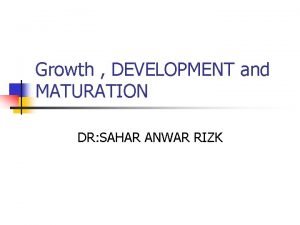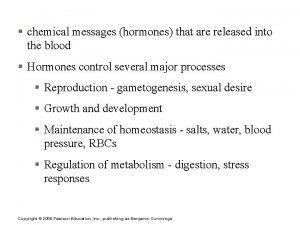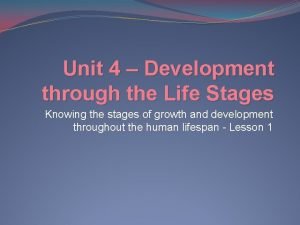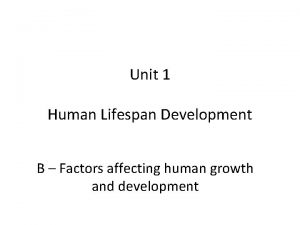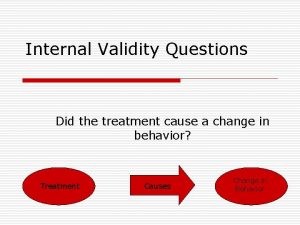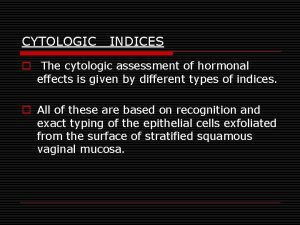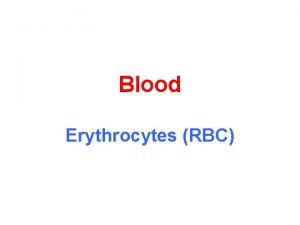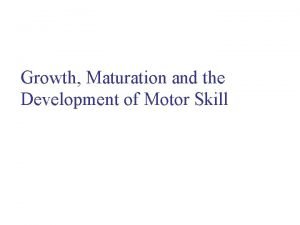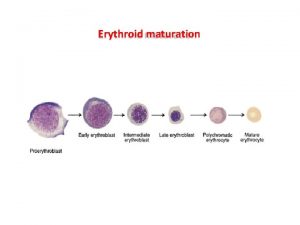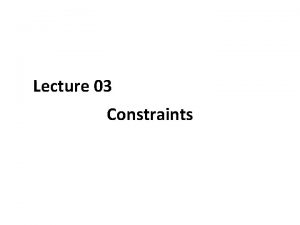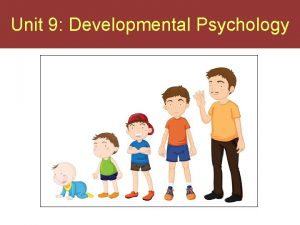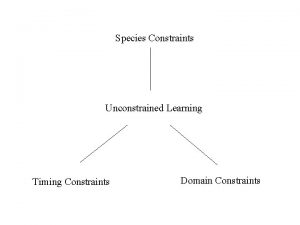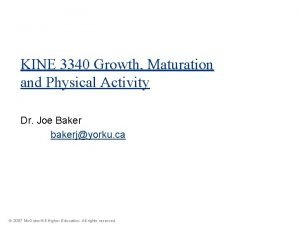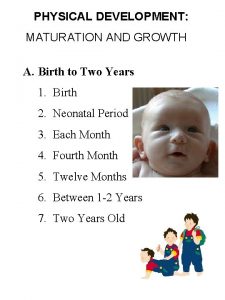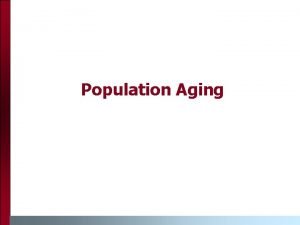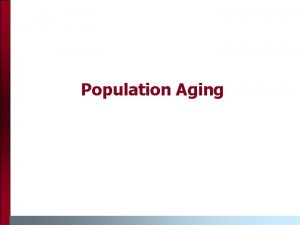PHYSICAL GROWTH MATURATION and AGING Changing Individual Constraints
































- Slides: 32

PHYSICAL GROWTH, MATURATION, and AGING (Changing Individual Constraints Across the Life Span) 1

PRENATAL DEVELOPMENT External factors can positively or negatively affect growth and maturation. Both genetic and external factors influence normal embryonic and fetal growth. 2

EMBRYONIC DEVELOPMENT 1 to 8 weeks 3

Formation of Sex Cells The genetic information that determines hair and eye colour, height potential, skeletal structure etc is contained in genes. The genes are located on chromosones. Humans have 23 pairs of chromosones in all their cells, except for the sex cells when they are formed. The sex cells are specialised cells formed by meiosis (reduction division). That is each sex cell divides into two “daughter” sex cells. Only one chromosone from each of the 23 pairs migrate to each daughter cell. 4

Which one of the pair each daughter cell receives is a matter of chance. When an ovum and spermatozoan unite in fertilisation each donates the “chance” set of 23 chromosones, reestablishing the total of 46 chromosones (23 pairs). Each human chromosone has 30 000 or more pairs of genes – that helps bring variety and that’s why each human being is unique. 5

CELL GROWTH AND DIFFERENTIATION The genes also direct the continuous development of the embryo in a precise and predictable pattern. The fertilised egg or zygote divides into two cells, four, eight and so on, by mitotic cell division. As the cells continue to increase they also differentiate to form specific tissues and organs. This process occurs in a predictable time line. The limbs are roughly formed and the heart beat begins at 4 weeks. Eyes , ears, nose, mouth, fingers and toes are formed at approximately 8 weeks. 6

FETAL DEVELOPMENT 9 to 38 weeks 7

The Fetal Stage From 8 weeks to birth there is further growth and cell differentiation of the fetus. Growth of organs and tissue happens in two ways: Ø 1) Hyperplasia – increase in the absolute number of cells. Ø 2) Hypertrophy – increase in the relative size of an individual cell. 8

It also happens in two directions: Ø 1) Cephalocaudal which is the direction of growth beginning at the head and extending towards the lower body. Ø 2) Proximodistall which is the direction of growth proceeding from the body toward extrimities. 9

FETAL NOURISHMENT • The fetus is nourished by the diffusion of oxygen and nutrients between fetal blood and maternal blood in the placenta. • Poor nourishment due to eg. poor socio economic status of the woman may lead to low birth weight in infant(s) risk of disease, infection, and death in the weeks after birth. 10

ABNORMAL PRENATAL DEVELOPMENT Abnormal development may arise from either genetic or external factors. 11

Genetic Causes of Abnormal Prenatal Development Dominant disorders result when one parent passes on defective gene. Recessive disorders occur when a defective gene comes from both parent. Genetic abnormalities can result from a mutation – the alteration or defection of a gene during formation of the egg or sperm cell. Both new mutations and inherited disorders can result in single or multiple malformations of an organ, limb or body region. 12

external Causes of Abnormal Prenatal Development Too little or too much of the necessary vitamins, nutrients and hormones can have an adverse effect on the fetus. Some of these substances can also act as malformation agents or teratogens. A teratogen is any drug or chemical agent that causes abnormal development in a fetus upon exposure. 13

Examples of Teratogens Include: Nutritional deficiencies; Hypervitaminosis; eg excess vitamin D. Drugs; eg. Cocaine; Alcohol Infections; Human Immunodeficiency Virus (HIV) – heights, weights, and head circumference below third percentile, head and facial abnormalities, cardiac defects, impaired growth, develop mental problems, cataracts, deafness. 14

Overall Growth The growth pattern is predictable and consistent but not linear. Height and weight are characterised by: Ø rapid growth after birth Ø gradual but steady growth during childhood Ø rapid growth during early adolescence Ø then levelling off. Thus the growth curves are roughly S shaped – sigmoid curve. 15

Gender differences are minimal in early childhood. Boys then are slightly taller and heavier. Throughout childhood, girls mature at a faster rate than boys. At a given age (childhood) girls as a group are biologically more mature than boys. On average girls begin their adolescent growth spurt at 9 and boys at 11 years. It is the “Age at takeoff” the age at which the rate of growth begins to increase. 16

Height On average girls reach peak height velocity during the adolescent growth spurt at 11. 5 to 12 years Boys reach peak height velocity at 13. 5 to 14 years Boys velocity is faster than that of girls( 9 cm/year). Growth in height tapers off at approximately 14 years for girls & 17 years for boys. Notable increase in height ending around 16 years for girls & 18 years for boys. Males have 2 more years of growth than females amounting to 10 to 13 cm of height. 17

Weight Rapid increase in infancy. Moderate in childhood. Spurt in early adolescence. Then steady increase that tapers off at the end of the growth period. Weight is susceptible to external factors. 18

Weight Variations in the amount of muscle with exercise and fat tissue with diet and exercise. Disease can also influence body weight. Peak weight velocity during the adolescent growth spurt follows peak height velocity. By 2. 5 to 5. 0 months in boys and 3. 5 to 10. 5 months in girls. Thus individuals grow “up” 1 st and then filling “out” 19

Relative Growth Each part of the growing individual has its own precise and orderly growth rate. The head is one fourth of the total height at birth but one eighth of adult height. The legs are about three eighths of the height at birth but almost half of adult height. The legs grow faster than the trunk and head in infancy and childhood. They undergo a growth spurt early in adolescence. Growth in height results mostly from an increase in trunk length during late adolescence and early childhood. 20

21

Relative Growth In girls, shoulder and hip growth increase at about the same rate. Their shoulder to hip ratio is fairly stable. Boys undergo a substantial increase in shoulder growth during their growth spurt. So boys’ ratio changes as they move into adolescence. 22

Physiological Maturation Tissues of the growing body can advance without necessarily increasing in size. Physiological maturation is the developmental process leading to a state of full function. Two children of the same age can be dramatically different in maturation status i. e. early and late maturer. It is difficult to assume maturity from age alone, size alone or even age and size together. 23

Physiological Maturation A child may be small and of slight build but may actually be relatively mature for his or her chronological (linear) age. Appearance of secondary sex characteristics during adolescent growth spurt is a function of maturation. Individuals who are more mature are likely to be stronger and more coordinated than those who are less mature even at the same chronological age. Educators must consider maturation status in designing activities and setting performance goals. It is tempting to assume movement performance potential from size alone or age alone, but in fact maturation status is a powerful predictor of performance potential. 24

MATURATION: INTERRELATIONSHIP WITH MOTOR PERFORMANCE Early maturation, with its associated size and strength advantages, establishes an asset positively associated with success in several sports. How ever, as adolescence approaches its termination, the maturity status of the youngsters is of less significance as the catch up of late maturing boys reduces the size differences so apparent in early adolescence. (1984, p. 56) 25

external Influence on Postnatal Growth During periods of rapid growth, just after birth and in early adolescence, growth is sensitive to alteration by environmental factors. There is “Catch up growth” which is relatively rapid physical growth of the body to recover some or all of the slow growth during a period of negative external influence once the negative influence is removed. 26

Assessment of Physiological Maturation Dental eruption – restricted to 6 months to 3 years and 6 to 13 years (permanent teeth). The appearance of secondary sex characteristics. Skeletal maturation – comparing an X ray of skeletal maturation to a set of standards. 27

Bones of the skeleton change in size and shape. These changes can be seen by x ray. The "bone age" of a child is the average at which children reach this stage of bone maturation. A child's current height and bone age can be used to predict adult height. At birth, only the metaphyses of the "long bones" are present. 28

The metaphysis is the wide portion of a long bone (femurs, tibias, fibulas humeri, radii, ulnas and phalanges of the fingers and toes) and between the epiphysis and the narrow diaphysis. [1] It is considered a part of the growth plate, the part of the bone that grows during childhood and as it grows, it ossifies near the diaphysis and the epiphyses. During childhood, the growth plate contains the connecting cartilage enabling the bone to grow; at adulthood (between the ages of 18 to 25 years), the components of the growth plate stop growing altogether and completely ossify into solid bone. 29

DEVELOPMENT OF PUBIC HAIR Males Stage 1. There is no pubic hair. Stage 2. There is a thin growth of long, slightly pigmented, downy hair, straight or only slightly curled, primarily at the base of the penis. Stage 3. The hair is considerably darker, rougher, and more curled. The hair spreads thinly over the intersection of the pubes. Stage 4. The hair, now adult in type, covers a smaller area than in the adult. The hair is adult in quantity and type. 30

DEVELOPMENT OF PUBIC HAIR Females Stage 1. There is no pubic hair. Stage 2. There is thin growth of long, lightly pigmented, downy hair, straight or only slightly curled, primarily along the labia. Stage 3. The hair is considerably darker, rougher, and more curled. The hair spreads sparsely over the intersection of the pubes. Stage 4. The hair, now adult in type, covers a smaller area than in the adult. The hair in adult is in quantity. 31

Adulthood and Aging Growth ends in the late teens or early twenties. Measures of body size can change in adulthood mostly due to external factors. Also the aging of tissues. Lack of weight bearing exercise and calcium in the diet could contribute to osteoporosis and resulting decrease in height. 32
 Growth development maturation
Growth development maturation Chapter 10:1 myths on aging
Chapter 10:1 myths on aging Growth analysis
Growth analysis Monocots vs eudicots
Monocots vs eudicots Primary growth and secondary growth in plants
Primary growth and secondary growth in plants Chapter 35 plant structure growth and development
Chapter 35 plant structure growth and development Learning is defined as:
Learning is defined as: Humoral stimulus
Humoral stimulus Carothers equation
Carothers equation Geometric growth vs exponential growth
Geometric growth vs exponential growth Neoclassical growth theory vs. endogenous growth theory
Neoclassical growth theory vs. endogenous growth theory Organic growth vs inorganic growth
Organic growth vs inorganic growth Definition of maturation
Definition of maturation Is sunlight necessary for seed germination
Is sunlight necessary for seed germination Maturational theory
Maturational theory Affinity maturation somatic hypermutation
Affinity maturation somatic hypermutation Gessel theory
Gessel theory Regression threat
Regression threat Maturation psychology
Maturation psychology Maturation index 0/90/10
Maturation index 0/90/10 Hyalomere and granulomere
Hyalomere and granulomere Stages of ameloblast
Stages of ameloblast Gesell theory
Gesell theory Maturation
Maturation Schuffner's granules
Schuffner's granules What is maturation
What is maturation Polychromatophilic erythroblast
Polychromatophilic erythroblast Growth and development in physical education
Growth and development in physical education Forms of meat in the market
Forms of meat in the market Jessie emily schofield summary
Jessie emily schofield summary Ricoh uky
Ricoh uky Dane county aging and disability resource center
Dane county aging and disability resource center Memory aging and brain maintenance
Memory aging and brain maintenance
